IntroductionJava Programming - Math Class
- 2. Standard Classes and Methods: The Math Class: Java Math class provides several methods to work on math calculations Fundamentals of Java 2 Table 4-1: Seven methods in the Math class
- 3. Standard Classes and Methods: The Math Class (cont.) • Using sqrt() method example: Fundamentals of Java 3
- 4. Standard Classes and Methods: The Math Class (cont.) Fundamentals of Java 4 Math class methods example:
- 5. Standard Classes and Methods: The Random Class • Random number generator: Returns numbers chosen at random from a pre-designated interval Fundamentals of Java 5 Table 4-2: Methods in the Random class
- 8. Defining Methods 8 A method is a collection of statements that are grouped together to perform an operation. public static int max(int num1, int num2) { int result; if (num1 > num2) result = num1; else result = num2; return result; } Define a method Invoke a method int z = max(x, y); actual parameters (arguments)
- 9. Defining Methods 9 A method is a collection of statements that are grouped together to perform an operation. public static int max(int num1, int num2) { int result; if (num1 > num2) result = num1; else result = num2; return result; } modifier return value type method name formal parameters return value method body method header parameter list Define a method Invoke a method int z = max(x, y); actual parameters (arguments) method signature
- 10. Method Signature 10 Method signature is the combination of the method name and the parameter list. public static int max(int num1, int num2) { int result; if (num1 > num2) result = num1; else result = num2; return result; } modifier return value type method name formal parameters return value method body method header parameter list Define a method Invoke a method int z = max(x, y); actual parameters (arguments) method signature
- 11. Formal Parameters 11 The variables defined in the method header are known as formal parameters. public static int max(int num1, int num2) { int result; if (num1 > num2) result = num1; else result = num2; return result; } modifier return value type method name formal parameters return value method body method header parameter list Define a method Invoke a method int z = max(x, y); actual parameters (arguments) method signature
- 12. Actual Parameters 12 When a method is invoked, you pass a value to the parameter. This value is referred to as actual parameter or argument. public static int max(int num1, int num2) { int result; if (num1 > num2) result = num1; else result = num2; return result; } modifier return value type method name formal parameters return value method body method header parameter list Define a method Invoke a method int z = max(x, y); actual parameters (arguments) method signature
- 13. Return Value Type 13 A method may return a value. The returnValueType is the data type of the value the method returns. If the method does not return a value, the returnValueType is the keyword void. For example, the returnValueType in the main method is void. public static int max(int num1, int num2) { int result; if (num1 > num2) result = num1; else result = num2; return result; } modifier return value type method name formal parameters return value method body method header parameter list Define a method Invoke a method int z = max(x, y); actual parameters (arguments) method signature
- 14. Calling Methods 14 public static void main(String[] args) { int i = 5; int j = 2; int k = max(i, j); System.out.println( "The maximum between " + i + " and " + j + " is " + k); } public static int max(int num1, int num2) { int result; if (num1 > num2) result = num1; else result = num2; return result; } pass the value of i pass the value of j
- 15. Reuse Methods from Other Classes NOTE: One of the benefits of methods is for reuse. The max method can be invoked from any class besides TestMax. If you create a new class Test, you can invoke the static method max using ClassName.methodName (e.g., TestMax.max). 15
- 18. Pass by Value 18 When you invoke a method with an argument, the value of the argument is passed to the parameter. This is referred to as pass-by-value. If the argument is a variable rather than a literal value, the value of the variable is passed to the parameter. The variable is not affected, regardless of the changes made to the parameter inside the method
- 19. Pass by Value 19
- 20. Overloading Methods • Overloading methods enables you to define the methods with the same name as long as their signatures are different. • The max method that was used earlier works only with the int data type. But what if you need to determine which of two floating-point numbers has the maximum value? The solution is to create another method with the same name but different parameters, as shown in the following code: public static double max(double num1, double num2) { if (num1 > num2) return num1; else return num2; } 20
- 21. Ambiguous Invocation • The Java compiler determines which method to use based on the method signature. • Sometimes there may be two or more possible matches for an invocation of a method, but the compiler cannot determine the most specific match. This is referred to as ambiguous invocation. Ambiguous invocation is a compile error. 21
- 23. Scope of Local Variables A local variable: a variable defined inside a method. Scope: the part of the program where the variable can be referenced. The scope of a local variable starts from its declaration and continues to the end of the block that contains the variable. A local variable must be declared before it can be used. 23
- 24. Scope of Local Variables, cont. You can declare a local variable with the same name multiple times in different non- nesting blocks in a method, but you cannot declare a local variable twice in nested blocks. 24
- 25. Scope of Local Variables, cont. A variable declared in the initial action part of a for loop header has its scope in the entire loop. But a variable declared inside a for loop body has its scope limited in the loop body from its declaration and to the end of the block that contains the variable. 25 public static void method1() { . . for (int i = 1; i < 10; i++) { . . int j; . . . } } The scope of j The scope of i
- 26. Scope of Local Variables, cont. 26 public static void method1() { int x = 1; int y = 1; for (int i = 1; i < 10; i++) { x += i; } for (int i = 1; i < 10; i++) { y += i; } } It is fine to declare i in two non-nesting blocks public static void method2() { int i = 1; int sum = 0; for (int i = 1; i < 10; i++) { sum += i; } } It is wrong to declare i in two nesting blocks
- 27. Benefits of Methods 27 • Write a method once and reuse it anywhere. • Information hiding. Hide the implementation from the user. • Reduce complexity.
- 28. Arrays • An array is an ordered list of values 28 0 1 2 3 4 5 6 7 8 9 79 87 94 82 67 98 87 81 74 91 An array of size N is indexed from zero to N-1 scores The entire array has a single name Each value has a numeric index This array holds 10 values that are indexed from 0 to 9
- 29. Arrays • A particular value in an array is referenced using the array name followed by the index in brackets • For example, the expression scores[2] refers to the value 94 (the 3rd value in the array) • That expression represents a place to store a single integer and can be used wherever an integer variable can be used 29
- 30. Arrays • For example, an array element can be assigned a value, printed, or used in a calculation: scores[2] = 89; scores[first] = scores[first] + 2; mean = (scores[0] + scores[1])/2; System.out.println ("Top = " + scores[5]); 30
- 31. Arrays • The values held in an array are called array elements • An array stores multiple values of the same type (the element type) • The element type can be a primitive type or an object reference • Therefore, we can create an array of integers, or an array of characters, or an array of String objects, etc. • In Java, the array itself is an object • Therefore the name of the array is a object reference variable, and the array itself must be instantiated 31
- 32. Declaring Arrays • The scores array could be declared as follows: int[] scores = new int[10]; • The type of the variable scores is int[] (an array of integers) • Note that the type of the array does not specify its size, but each object of that type has a specific size • The reference variable scores is set to a new array object that can hold 10 integers 32
- 33. Declaring Arrays • Some examples of array declarations: float[] prices = new float[500]; boolean[] flags; flags = new boolean[20]; char[] codes = new char[1750]; 33
- 34. Bounds Checking • Once an array is created, it has a fixed size • An index used in an array reference must specify a valid element • That is, the index value must be in bounds (0 to N-1) • The Java interpreter throws an ArrayIndexOutOfBoundsException if an array index is out of bounds • This is called automatic bounds checking 34
- 35. Bounds Checking • For example, if the array codes can hold 100 values, it can be indexed using only the numbers 0 to 99 • If count has the value 100, then the following reference will cause an exception to be thrown: System.out.println (codes[count]); • It’s common to introduce off-by-one errors when using arrays 35 for (int index=0; index <= 100; index++) codes[index] = index*50 + epsilon; problem
- 36. Bounds Checking • Each array object has a public constant called length that stores the size of the array • It is referenced using the array name: scores.length • Note that length holds the number of elements, not the largest index 36
- 37. Alternate Array Syntax • The brackets of the array type can be associated with the element type or with the name of the array • Therefore the following declarations are equivalent: float[] prices; float prices[]; • The first format generally is more readable 37
- 38. Initializer Lists • An initializer list can be used to instantiate and initialize an array in one step • The values are delimited by braces and separated by commas • Examples: int[] units = {147, 323, 89, 933, 540, 269, 97, 114, 298, 476}; char[] letterGrades = {'A', 'B', 'C', 'D', ’F'}; 38
- 39. Initializer Lists • Note that when an initializer list is used: • the new operator is not used • no size value is specified • The size of the array is determined by the number of items in the initializer list • An initializer list can only be used only in the array declaration 39
- 40. Arrays as Parameters • An entire array can be passed as a parameter to a method • Like any other object, the reference to the array is passed, making the formal and actual parameters aliases of each other • Changing an array element within the method changes the original • An array element can be passed to a method as well, and follows the parameter passing rules of that element's type 40
- 41. Arrays of Objects • The elements of an array can be object references • The following declaration reserves space to store 53 references to String objects String[] words = new String[53]; • It does NOT create the String objects themselves • Each object stored in an array must be instantiated separately 41
- 42. Command-Line Arguments • The signature of the main method indicates that it takes an array of String objects as a parameter • These values come from command-line arguments that are provided when the interpreter is invoked • For example, the following invocation of the interpreter passes an array of three String objects into main: > java delhi colcutta jaipur bangalore • These strings are stored at indexes 0-3 of the parameter 42
- 43. Arrays of Objects • Objects can have arrays as instance variables • Many useful structures can be created with arrays and objects • The software designer must determine carefully an organization of data and objects that makes sense for the situation 43
- 45. Two-Dimensional Arrays • A one-dimensional array stores a list of elements • A two-dimensional array can be thought of as a table of elements, with rows and columns 45 one dimension two dimensions
- 46. Two-Dimensional Arrays • To be precise, a two-dimensional array in Java is an array of arrays • A two-dimensional array is declared by specifying the size of each dimension separately: int[][] scores = new int[12][50]; • A two-dimensional array element is referenced using two index values value = scores[3][6] • The array stored in one row or column can be specified using one index 46
- 47. Two-Dimensional Arrays Expression Type Description scores int[][] 2D array of integers, or array of integer arrays scores[5] int[] array of integers scores[5][12] int integer 47
- 48. Multidimensional Arrays • An array can have many dimensions • If it has more than one dimension, it is called a multidimensional array • Each dimension subdivides the previous one into the specified number of elements • Each array dimension has its own length constant • Because each dimension is an array of array references, the arrays within one dimension can be of different lengths • these are sometimes called ragged arrays 48
- 49. 49

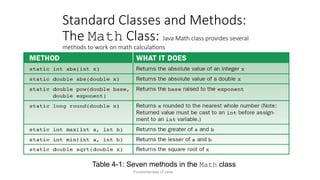

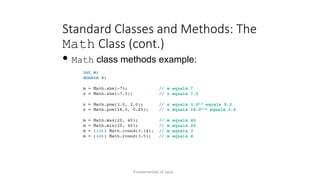








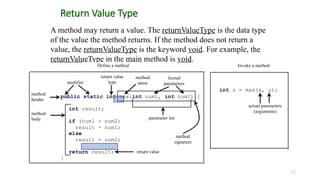
![Calling Methods
14
public static void main(String[] args) {
int i = 5;
int j = 2;
int k = max(i, j);
System.out.println(
"The maximum between " + i +
" and " + j + " is " + k);
}
public static int max(int num1, int num2) {
int result;
if (num1 > num2)
result = num1;
else
result = num2;
return result;
}
pass the value of i
pass the value of j](https://image.slidesharecdn.com/unit1-241014011820-06ad239d/85/IntroductionJava-Programming-Math-Class-14-320.jpg)







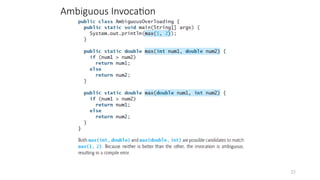






![Arrays
• A particular value in an array is referenced using the array name
followed by the index in brackets
• For example, the expression
scores[2]
refers to the value 94 (the 3rd value in the array)
• That expression represents a place to store a single integer and can be
used wherever an integer variable can be used
29](https://image.slidesharecdn.com/unit1-241014011820-06ad239d/85/IntroductionJava-Programming-Math-Class-29-320.jpg)
![Arrays
• For example, an array element can be assigned a value, printed, or
used in a calculation:
scores[2] = 89;
scores[first] = scores[first] + 2;
mean = (scores[0] + scores[1])/2;
System.out.println ("Top = " + scores[5]);
30](https://image.slidesharecdn.com/unit1-241014011820-06ad239d/85/IntroductionJava-Programming-Math-Class-30-320.jpg)

![Declaring Arrays
• The scores array could be declared as follows:
int[] scores = new int[10];
• The type of the variable scores is int[] (an array of integers)
• Note that the type of the array does not specify its size, but each
object of that type has a specific size
• The reference variable scores is set to a new array object that can
hold 10 integers
32](https://image.slidesharecdn.com/unit1-241014011820-06ad239d/85/IntroductionJava-Programming-Math-Class-32-320.jpg)
![Declaring Arrays
• Some examples of array declarations:
float[] prices = new float[500];
boolean[] flags;
flags = new boolean[20];
char[] codes = new char[1750];
33](https://image.slidesharecdn.com/unit1-241014011820-06ad239d/85/IntroductionJava-Programming-Math-Class-33-320.jpg)

![Bounds Checking
• For example, if the array codes can hold 100 values, it can be
indexed using only the numbers 0 to 99
• If count has the value 100, then the following reference will cause
an exception to be thrown:
System.out.println (codes[count]);
• It’s common to introduce off-by-one errors when using arrays
35
for (int index=0; index <= 100; index++)
codes[index] = index*50 + epsilon;
problem](https://image.slidesharecdn.com/unit1-241014011820-06ad239d/85/IntroductionJava-Programming-Math-Class-35-320.jpg)

![Alternate Array Syntax
• The brackets of the array type can be associated with the element
type or with the name of the array
• Therefore the following declarations are equivalent:
float[] prices;
float prices[];
• The first format generally is more readable
37](https://image.slidesharecdn.com/unit1-241014011820-06ad239d/85/IntroductionJava-Programming-Math-Class-37-320.jpg)
![Initializer Lists
• An initializer list can be used to instantiate and initialize an array in
one step
• The values are delimited by braces and separated by commas
• Examples:
int[] units = {147, 323, 89, 933, 540,
269, 97, 114, 298, 476};
char[] letterGrades = {'A', 'B', 'C', 'D', ’F'};
38](https://image.slidesharecdn.com/unit1-241014011820-06ad239d/85/IntroductionJava-Programming-Math-Class-38-320.jpg)


![Arrays of Objects
• The elements of an array can be object references
• The following declaration reserves space to store 53 references to
String objects
String[] words = new String[53];
• It does NOT create the String objects themselves
• Each object stored in an array must be instantiated separately
41](https://image.slidesharecdn.com/unit1-241014011820-06ad239d/85/IntroductionJava-Programming-Math-Class-41-320.jpg)


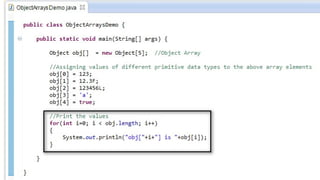

![Two-Dimensional Arrays
• To be precise, a two-dimensional array in Java is an
array of arrays
• A two-dimensional array is declared by specifying the
size of each dimension separately:
int[][] scores = new int[12][50];
• A two-dimensional array element is referenced using
two index values
value = scores[3][6]
• The array stored in one row or column can be
specified using one index
46](https://image.slidesharecdn.com/unit1-241014011820-06ad239d/85/IntroductionJava-Programming-Math-Class-46-320.jpg)
![Two-Dimensional Arrays
Expression Type Description
scores int[][] 2D array of integers, or
array of integer arrays
scores[5] int[] array of integers
scores[5][12] int integer
47](https://image.slidesharecdn.com/unit1-241014011820-06ad239d/85/IntroductionJava-Programming-Math-Class-47-320.jpg)

